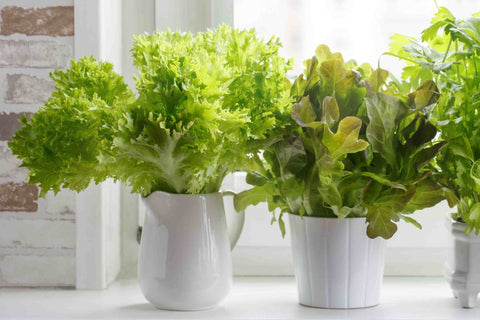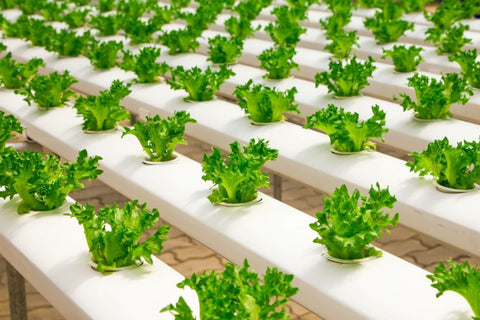Lettuce is best when harvested minutes before eating. It’s crisper, more flavorful, and more nutritious than store-bought lettuce, which is often over a week old. Lettuce and other leafy greens will be the fastest-growing plants in your indoor edible garden—if you provide enough water, nutrients, and light. In this blog, we’ll discuss what they need, planter options, and how to care for them for healthy, productive plants.
Growing Lettuce & Leafy Greens Indoors
This group includes head lettuce, leaf lettuce, and other greens like kale, arugula, and celery. These leafy greens are called “cool weather crops” because outdoors, they’re the first to grow after winter and make seeds by mid-summer. Their rapid growth means a short growing season. Combined with their susceptibility to pests, they grow better, longer, and more consistently indoors.
What’s the Best Planter for Lettuce & Leafy Greens?
Free Draining Pot vs Self-Watering Planter
These plants like consistent, moist soil. If you can check daily and adjust soil moisture, a simple pot works well. However, for a more practical and productive approach, we recommend a self-watering planter. They maintain consistent soil conditions and fit better into a weekly care routine. The roots of these plants are resistant to root rot, so they work in all types of self-watering planters. We recommend ceramic-based self-watering planters for their precision, cleanliness, and flexibility to grow various plants, but these plants also work in wick-based planters.
Self-Watering Planter vs. Hydroponics
As these plants like wet soil, they can also grow hydroponically, where roots grow directly into nutrient-enriched water. Hydroponics come in various forms, typically with a pump to move water and special nutrients, making them more expensive. Most plants grow as well or better in consistently moist soil, so hydroponics may not always be worth the extra complexity. However, lettuce can grow twice as fast in hydroponics, so if maximizing growth is important, it’s worth the investment.
How to Grow Leafy Greens in a Ceramic Self-Watering Planter
The instructions below are relevant to our upcoming Self-Watering Planter, which may be released in summer 2021. Current market options include Wet Pots, COSWIP, and the Great Northern. Wet Pots maintain the best soil moisture levels for leafy greens.
How to Fill the Self-Watering Planter
The ceramic material in different planters lets in varying amounts of water, but the soil wetness will be directly proportional to how high you fill the reservoir. Factors like plant size and light impact the reservoir level needed, so it’s best to monitor the soil. For leafy greens, keep the soil fairly wet. Let the water drop until the top ½ inch of soil is dry—this is your “low fill” line. Fill the planter to the top whenever it goes below this mark.
What Type of Planters & Soil Should You Use?
Regular potting mix works great for these plants. When starting, add an initial charge of balanced slow-release fertilizer following the manufacturer’s recommendation to feed your plant for the first 3 months.
When Should You Add Fertilizer?
These plants are moderate to heavy feeders—they grow quickly and need additional nutrients to replace what they use. They prefer a High-N fertilizer. If you notice pale leaves or slower growth, add more fertilizer. You can use water-soluble (every 1-2 weeks), granular (4-8 weeks), or slow-release (10-14 weeks) fertilizers following the manufacturer’s dose. Avoid getting liquid fertilizer on the plant leaves.
Companions
These plants thrive in nutrient-rich environments, so they’re accustomed to having close neighbors.







There are no comments for this article. Be the first one to leave a message!